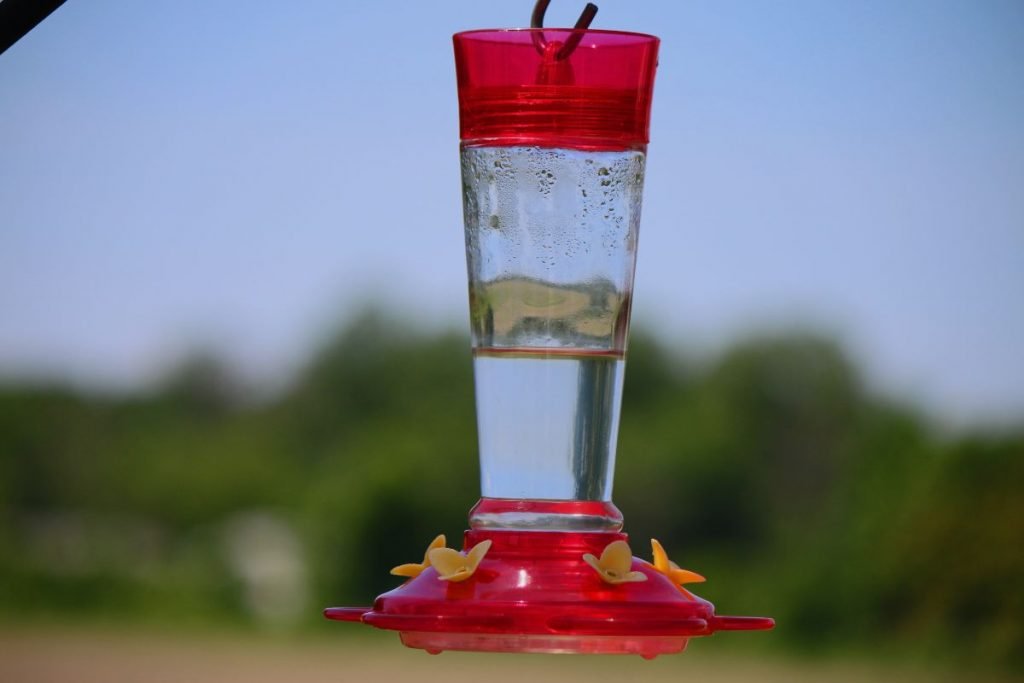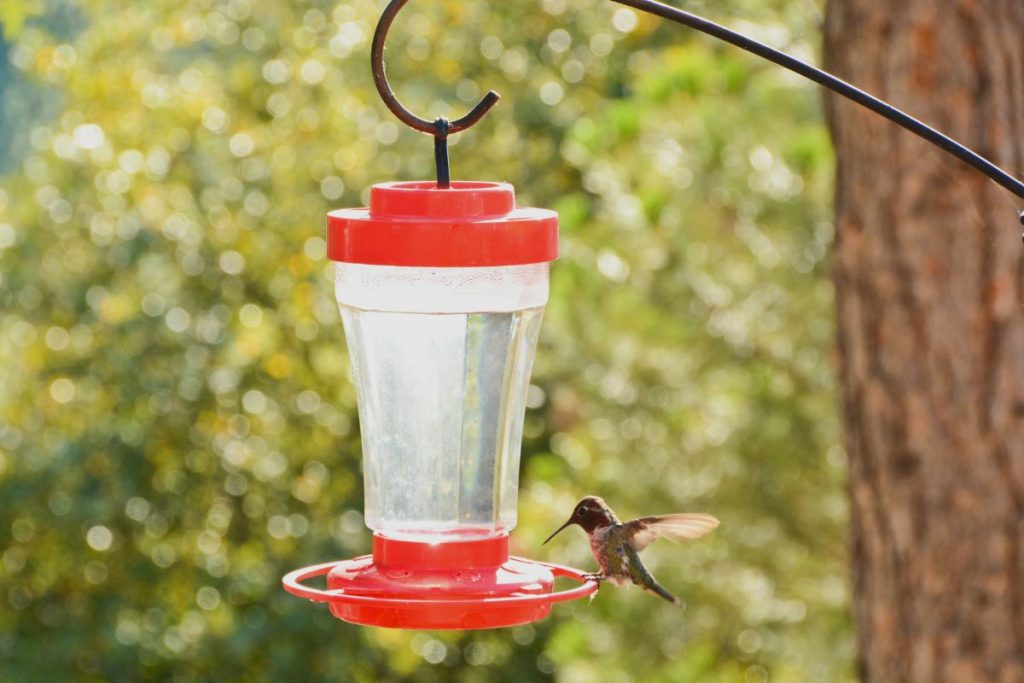Hummingbird feeders should be positioned approximately 4 to 5 feet off the ground. This height ensures that the feeders are within a hummingbird’s typical flight path, offering easy access and visibility while also deterring many potential predators and larger birds.
In this post, we will delve into the intricate considerations surrounding hummingbird feeder placement. From the influence of direct sunlight to the impact of the feeder’s height on attracting these fascinating creatures, we’ll provide comprehensive advice for bird lovers and casual observers alike.
Related posts to read:
Best Hummingbird Feeders.
Hummingbird Feeders Comprehensive Guide.

The Importance of Hummingbird Feeder Height
Choosing the right height for your hummingbird feeders is critical for several reasons. Notably, the 4 to 5 feet height is within the normal flying range for most species of hummingbirds, including the popular Ruby-throated Hummingbirds. This optimal location encourages hummingbirds to visit, making your garden a high-traffic area for these beautiful creatures during the warmer months.
Balancing Accessibility and Safety
Hummingbird feeder placement should also consider accessibility for hummingbirds and safety from predators. A feeder hung at an accessible location, perhaps on a bird feeder pole or a plant hanger bracket, allows hummingbirds to easily locate the sweet nectar within. However, this should be balanced against potential threats from natural predators, such as cats and larger birds. An ideal spot would offer a safe location with natural cover and adequate cover that these smaller birds can retreat to if threatened.
Understanding Sun and Shade Requirements
While hummingbirds are fond of the warm sun, they also appreciate cooler temperatures in the dappled shade. Positioning hummingbird feeders in partial sunlight or a shaded location, away from direct sunlight, is an essential aspect of feeder placement.
A perfect spot offers beneficial afternoon shade and protection from extreme temperatures, ensuring that the nectar stays fresh for longer. A feeder in the blazing sun may result in hot nectar, which can ferment and become unappealing to hummingbirds.
Preventing Bird Collisions with Window Hummingbird Feeders
If you’ve chosen a window hummingbird feeder, be aware of the risk of bird collisions. A feeder attached to a pane of glass via a suction cup should be either close enough (i.e., less than 3 feet away) so the birds recognise the window as a solid barrier or far enough (i.e., more than 10 feet away) that they have enough room to avoid a crash.
Keeping the Nectar Fresh and Feeders Clean
Hummingbird nectar, often a simple sugar water solution made from granulated sugar or white table sugar, can spoil if not kept fresh. During hot weather, fresh nectar should be replaced every two days.
On cooler days, you might stretch this to four or five days, but never longer. Remember, always keep your feeders clean to prevent any mould growth and keep your hummingbirds healthy.

Attracting Hummingbirds to Your Feeder
Active hummingbird feeders can transform your garden into a hummingbird paradise, especially when they are supplemented with other food sources such as hummingbird flowers or hummingbird houses.
A hummingbird garden, for example, could include nectar-rich flowers, water sources like bird baths for hummingbirds, and hummingbird feeders placed around a shaded spot to provide plenty of nectar and attract hummingbirds.
Final Thoughts
You’ve now learned about the best placement for a hummingbird feeder and the ideal height for it. But it’s not just about the details—it’s about creating a welcoming space for these tiny birds, turning your garden into a thriving haven where nature can flourish. Your attention and effort make these special moments with hummingbirds possible.
Isn’t it amazing that simply adjusting the height of a feeder can have such a big impact on the behaviour of these beautiful creatures in your own backyard? It makes you wonder what other small changes could bring even more of nature’s beauty into your life.
Think about it—if changing the height of a feeder can make such a difference, what other simple actions could we take to invite more of nature’s wonders into our world? As you enjoy your morning tea, imagine sharing that peaceful moment with a hummingbird. It’s an interesting thought, isn’t it?
If you found this content helpful, please feel free to share it with others who might also benefit from it.
Thank you for taking the time to read this blog post and happy birdwatching.
FAQs – How High Should Hummingbird Feeder Be?
Q: What is the recommended height for a hummingbird feeder?
A: The recommended height for a hummingbird feeder is approximately 4 to 5 feet off the ground.
Q: How does the height of the feeder influence hummingbird visits?
A: The height of the feeder can greatly influence hummingbird visits as it needs to be within their typical flight path. A feeder positioned 4 to 5 feet off the ground is easily accessible and visible to hummingbirds.
Q: What considerations should be taken into account for hummingbird feeder placement?
A: Hummingbird feeder placement should consider the feeder’s accessibility for hummingbirds, safety from potential predators and larger birds, and the balance between direct sunlight and shade.
Q: How does direct sunlight affect hummingbird feeders?
A: Direct sunlight can cause the nectar in hummingbird feeders to ferment and become unappealing. Placing the feeder in a shaded spot helps keep the nectar fresh for longer.
Q: Can a hummingbird feeder be attached to a window?
A: Yes, a hummingbird feeder can be attached to a window using a suction cup. However, to prevent bird collisions, it should be either close enough so birds recognise the window as a solid barrier or far enough to allow room for them to avoid a crash.
Q: How often should the nectar in a hummingbird feeder be replaced?
A: During hot weather, the nectar in a hummingbird feeder should be replaced every two days. On cooler days, this can be extended to four or five days.
Q: What factors should be considered when creating a hummingbird garden?
A: A hummingbird garden should include hummingbird feeders, water sources like bird baths, and nectar-rich flowers, all placed in shaded locations to attract hummingbirds.
Q: Can the feeder’s height deter predators?
A: Yes, a feeder placed at a height of about 4 to 5 feet can deter many predators, including cats and larger birds, offering a safe location for hummingbirds to feed.
Q: What can be done to prevent nectar from fermenting in hot weather?
A: To prevent nectar from fermenting, place the feeder in a shaded location away from direct sunlight and ensure it is replaced every two days during hot weather.
Q: What is the ideal location for a hummingbird feeder in relation to sun and shade?
A: The ideal location for a hummingbird feeder offers a balance between sunlight and shade. Partial sunlight or beneficial afternoon shade can help keep the nectar fresh and cool.
Q: What sugar is best to use for hummingbird nectar?
A: White granulated sugar or white table sugar is best for making hummingbird nectar. Brown sugar and artificial sweeteners should be avoided.
Q: How does the height of the feeder affect the safety of hummingbirds?
A: A properly positioned feeder allows hummingbirds to feed while maintaining a safe distance from potential predators. Natural cover nearby also provides a safe retreat if needed.
Q: Do hummingbirds prefer a particular type of hummingbird feeder?
A: Hummingbirds are not particularly picky about the type of feeder but are attracted to feeders that offer fresh nectar, are clean, and are placed at an appropriate height.
Q: How can I make my hummingbird feeder more visible to hummingbirds?
A: Placing your hummingbird feeder in an area with a clear flight path, at the recommended height, and near other food sources like nectar-rich flowers can make it more visible and attractive to hummingbirds.
Q: How does temperature affect the freshness of hummingbird nectar?
A: Temperature greatly affects the freshness of hummingbird nectar. High temperatures can cause the nectar to ferment quickly, so it’s important to replace it more often during warmer periods.
Q: Should I use food colouring in hummingbird nectar?
A: No, food colouring should not be used in hummingbird nectar. The chemicals can be harmful to the birds. The red colour on the feeder itself is usually enough to attract hummingbirds.
Q: Can other birds use a hummingbird feeder?
A: While other birds may be attracted to a hummingbird feeder, the feeder’s design and the nectar itself are intended for hummingbirds. The height of the feeder also deters larger birds.
Q: What are some common predators of hummingbirds?
A: Common predators of hummingbirds include cats, larger birds, and predatory insects. The height and location of the feeder can help protect hummingbirds from these threats.
Q: What kind of water source is suitable for a hummingbird garden?
A: Bird baths or shallow dishes with water can serve as water sources in a hummingbird garden. The water should be fresh and clean.
Q: Is it necessary to clean hummingbird feeders, and how often?
A: Yes, it’s essential to keep hummingbird feeders clean to prevent the growth of mould and bacteria. It’s recommended to clean the feeders every time you replace the nectar.
Image Gallery – How High Should Hummingbird Feeder Be?



Other related posts to read:
References:
- About Hummingbird (Wikipedia).
- About Bird Feeder (Wikipedia)
- Greenewalt, C. H. (1960). Hummingbirds. New York: Doubleday. Google Scholar.
